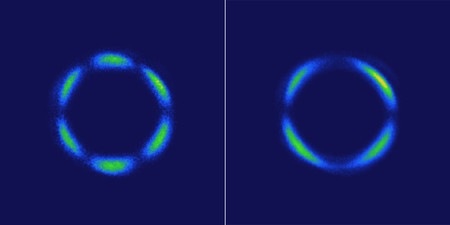
These images show light patterns generated by a rhenium-based crystal using a laser method called optical second-harmonic rotational anisotropy. At left, the pattern comes from the atomic lattice of the crystal. At right, the crystal has become a 3-D quantum liquid crystal, showing a drastic departure from the pattern due to the atomic lattice alone.
A new paper by the Hsieh group titled A parity-breaking electronic nematic phase transition in the spin-orbit coupled metal Cd2Re2O7 describes the experimental discovery of one member of a new class of odd-parity Fermi liquid instabilities expected to appear in correlated metals with strong spin-orbit coupling.
“We have detected the existence of a fundamentally new state of matter that can be regarded as a quantum analog of a liquid crystal,” says Caltech assistant professor of physics David Hsieh, principal investigator on a new study describing the findings in the April 21 issue of Science. “There are numerous classes of such quantum liquid crystals that can, in principle, exist; therefore, our finding is likely the tip of an iceberg.”
Nematic phases in 2D electron systems have been known for several years. John Harter, a postdoctoral scholar in the Hsieh lab and lead author of the new study, explains how these previously-discovered 2D quantum liquid crystals behave in strange ways. “Electrons living in this flatland collectively decide to flow preferentially along the x-axis rather than the y-axis even though there’s nothing to distinguish one direction from the other,” he says.
Now Harter, Hsieh, and their colleagues at Oak Ridge National Laboratory and the University of Tennessee have discovered the first 3D quantum liquid crystal. Compared to 2D, the 3D version is even more bizarre. Here, the electrons not only make a distinction between the x-, y-, and z-axes, but they have opposite spin direction depending on whether they flow forward or backward on a given axis. This new behavior emerges due to strong spin-orbit coupling.
The discovery is exciting because even-parity 2D electronic nematic order has been proposed as a precursor to high-temperature superconductivity, and it is possible that 3D electronic nematics could lead to exotic odd-parity topological superconductors that may be relevant to quantum computing. “Rather than rely on serendipity to find topological superconductors, we may now have a route to rationally creating them using 3D quantum liquid crystals” says Harter. “That is next on our agenda.”
Read the full Caltech Media story about the paper.
Read the full paper: J.W. Harter, Z. Y. Zhao, J.-Q. Yan, D. G. Mandrus, D. Hsieh. A parity-breaking electronic nematic phase transition in the spin-orbit coupled metal Cd2Re2O7. Science 356, 6335, pp. 295-299 (2017).



